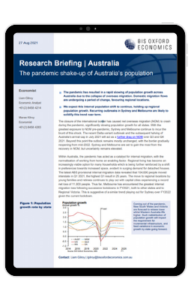Australia | The pandemic shake up of Australia’s population

The closure of the international border has caused net overseas migration (NOM) to crash during the pandemic, significantly slowing population growth for all states. With the greatest exposure to NOM pre-pandemic, Sydney and Melbourne continue to incur the brunt of this shock. The recent Delta variant outbreak and the subsequent halving of Australia’s arrival cap in July 2021 will act as a further drag on NOM over Q3 and Q4 2021. Beyond this point the outlook remains mostly unchanged, with the border gradually reopening from mid-2022.
What you will learn:
- The pandemic has resulted in a rapid slowing of population growth across Australia due to the collapse of overseas migration. Domestic migration flows are undergoing a period of change, favouring regional locations.
- We expect this internal population shift to continue, holding up regional population growth. Recurring outbreaks in Sydney and Melbourne are likely to solidify this trend near term.
- Further analysis on Australia’s population growth rate by state.
Tags:
Related Services

Post
UK: Supply constraints are probably less prominent in the south
The extent to which UK employers can respond to likely 2024 interest rate cuts with increased output, rather than rises in prices and wages, will partly reflect the extent of spare capacity. This will inevitably vary by region. Evidence on this is imperfect, but in terms of capital assets (including intangibles) and labour availability, southern regions appear to be in a stronger position than those in the UK's traditional industrial heartland.
Find Out More
Post
Global Private equity real estate fund maturities spur asset sales
We expect the significant increases in fund maturities, spurred by capital raised over the past decade, to exert upward pressure on the rate of asset disposals as the funds approach the end of their lifecycles.
Find Out More